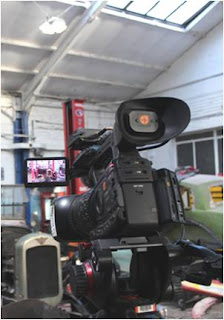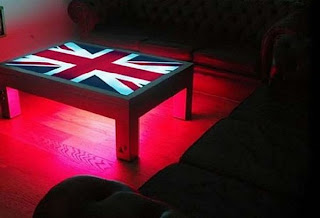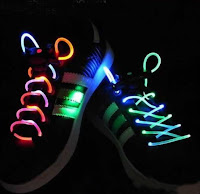The LED lighting market was estimated to have grown by 50%
between 2010 and 2011 according to a recent report by the Clean Revolution,
which estimates that the industry will be worth more than $16 billion by the
year 2014.
 |
| LED Car Park lighting on display in Sheffield |
And if the recent showing at the LuxLive exhibition was
anything to go by (read our account from the show back in November
here), LED lighting is quickly becoming the most talked about new technology
in the market.
Each lighting installation may be different, but here we
explain why LEDs are superior in many ways to more traditional lighting
solutions, and just why the LED lighting industry is one of the few bucking the
current economic trend and growing year on year.
Efficiency
LED stands for Light Emitting Diode, and is a technology
that is said to date back as far as the 1920s, with the Russian Oleg Losev.
LEDs as a light source are far more efficient than incandescent or fluorescent sources,
due to their better use of power. The total power output of a light does not
just include the visible light emitted, but also takes into account factors such as the amount
of base power that is converted into excess heat. When it comes to replacing traditional light bulbs in the home for example they
are difficult to handle because of the temperature - an example of how
excess heat is to the detriment of the user. Now imagine that on an industrial
scale and already one benefit of LED becomes clear. LED in fact operates best
in cooler temperatures, and lighting manufacturers often design fittings with
as minimal heat loss as possible in mind. LED lights are often better
positioned than traditional alternatives also, and this is due to the fact that
it is a directional light source, so minimal light pollution is caused by using
LEDs and the targeted area receives the maximum amount of light. More on this
in the environment section below.
Longevity
 |
| Hotels are just one of the industries utilising LED lighting |
The long lifespan of LED lighting is down to its robust
nature, as a solid-state light source the output of its light will degrade over
time like any other, however with LEDs that amount of time can be as much as
80,000 hours. At this point the power of light emitted from the LED will be at
around 75% of its total capacity but will continue at this level for another 20,000
hours before the light needs replacing. That works out as more than eleven years’
worth of light output, or based on an average day running lighting for twelve
hours, more than 22 years’ worth. This is assuming that the lighting is installed in optimum
conditions whereby factors such as temperature has been taken into account.
This longevity also means the frequency in which LED lighting need be replaced
is dramatically reduced when compared to CFL or HPS lighting, making further
savings for the user on maintenance bills. Read more below on the savings LED
can make.
Durability
Despite their compact size, LEDs are made to a high
specification and good quality products are made to last. As well as their
aforementioned longevity, LED lights are also durable with no filaments to burn
out or overheat. High quality designs, particularly that of a
UK manufacturer such as Gemma Lighting, make their fittings to a high specification that stands
up to heavy scrutiny, and offer products with protection ratings of IP66,
making them dust proof and resistant to heavy weather such as high winds and
heavy downpours. In circumstances where lights are on a tall column, such as
LED Street Lighting for example, the problem of vandalism regarding the actual
light fitting may not seem such an issue. However for pathways and ceiling
tiles this could play a part in a company’s decisions not to invest in a new
raft of lighting solutions. But with the high standards of production LED
lighting is actually quite safe from such hooliganism, and users can feel quite
safe about installing LED lighting solutions. Due to all these factors combined, the maintenance om/index.html
UK LED Lighting Manufacturer costs usually set by to replace faulty or flickering bulbs and
repair or replace vandalised lights can be a thing of the past for lighting users
switching to LED. Reductions in the tens of thousands of pounds have been
achieved by those who have already done just that, and the rewards pay off from
day one of the new installation.
Eco-friendly
 |
LED lighting has drastically improved
this car park in Portsmouth |
As well as being kind to the bank balances of users, LED
lighting is far more environmentally friendly than traditional lighting setups.
As mentioned already in this blog, LED lights emit less wasted heat energy and
therefore reduce light pollution significantly when compared to other lighting
choices. Take
LED Street Lighting for example, where bright white light is
directed in the appropriate angle enabling less light to overspill into neighbouring
areas, particularly useful in this application as nearby residents do not
suffer from intrusive light glare. Those who have made the switch to LED
lighting have also seen dramatic reduction in their carbon emissions, saving
tonnes of carbon waste every year. This, in fact, is the main driver for some making
the change to LED, as new directives and policies are drawn up in line with
national and global environmental policies. With no mercury involved in LEDs,
as explained below, the disposal of LED lighting is also better on the
environment.
Safety
The volatile nature of elements such as mercury can mean
disposing of old lighting is a major problem, particularly for business users.
Shedding several units of large, outdated lighting fittings is time-consuming and
a poor use of funds for many companies already feeling the strain in current
economic times. Disposals such as this must be done though if previous lighting
contains high levels of mercury or lead, as they can be harmful if they are not
dealt with correctly at the end of their life span. LEDs are far safer and more
environmentally friendly as they contain no mercury and increasingly small
amounts of lead. They can be disposed of and recycled more quickly and easily,
but with their longevity you won’t have to worry about that for many years
after installation.
Power
 |
This Portsmouth street was vastly improved
in an LED Street Lighting council-backed trial |
It is a myth attached to LED lighting that all these benefits
surrounding lower carbon emissions and cheaper running costs must mean a weaker
light. Many homeowners will be familiar with the patience required to wait for
a domestic energy saving light bulb to power up to full brightness for example.
However this is not true of LEDs - as well as an instant strike-up time, more on this below, they in fact have a very high lumen output, which means their power is equal to, and often greater than, similar lighting
solutions available. The amount of lumens per watt on LEDs are also increasing, with some
industry big-hitters claiming to have topped 250 l/w in the labs at the recent
LuxLive exhibition. This was previously thought to be an area of weakness for
the LED but progress in production and software design has meant this is no
longer the case with high-end products on the market today.
Adaptable
LED is probably best known for televisions and mobile device
backlighting. But with the increased
specifications now available LEDs are
being used in a variety of ways by a variety of people. You can find LED
lighting in street lights, car parks and pathways, as well as in warehouses,
cold stores and offices. Hospitals, universities, housing developments, police
stations, supermarkets, restaurants – they are all seeing the benefits of LED.
Available in a range of different fixtures and fittings, LED lighting now comes
in all shapes and sizes and is ready for almost any application. Some weird and
wacky ideas are being dreamt up too, but these shouldn't detract from what LED
lighting is really about, a great way of keeping costs down and reducing the
impact on the environment. Gemma Lighting offers high uniformity across many of
its ranges, making the switch to LED as simple as possible.
Improved clarity
 |
LED Street lighting can be found in Egypt,
the Falkland Islands and shown here in Dubai |
As well as a high lumen output LED lighting also provides
excellent colour rendering, making it ideal for instances where colour
definition is crucial, such as shop windows, stalls and supermarkets. Hotels
and restaurants can also benefit from this characteristic when attempting to
set a certain mood in a particular room. The same is also true of security requirements,
as the visual acuity of LED lighting is excellent, improving the clarity of
pictures from CCTV cameras, again a perfect application of LED in areas such as
warehouses or exterior storage facilities needing
LED Flood Lighting.
Instant
Unlike the common energy saving light bulbs found across
many homes today, as mentioned beforehand, LEDs do not take any time to get
going. In fact that is a literal statement; LEDs have an instant strike up
time of 100 nanoseconds. As well as adding to their energy efficiency this also means LEDs are
excellent contributing partners to motion sensor technology – they will light
as soon as movement is detected, and switch off as soon as that movement
ceases. This reduces the effect that some current security systems are suffering
from, whereby activation at the slightest movement becomes part of everyday life to home owners, defeating the object of having them as warning
systems against crimes such as burglary. LEDs are making homes and business premises alike more secure.
Aesthetically
pleasing
 |
LED Flood lighting was chosen in the
re-design of the River Hull tidal barrier |
An increasing amount of LED control technology is being
produced to complement LED lighting, and that includes dimmable switches. This appeals
further to those wishing to create a mood, as previously mentioned, or those
with particular requirements to the level of lighting in any given room. Adding
to their adaptability, this feature also shows the design benefits LED lighting
can bring. LEDs are being used more and more for aesthetic measures as well as
cost-cutting projects, and companies in the broadcasting and marine industries
are among those putting this to good use. The more powerful, clear bright white
light of LEDs is often the ideal companion to buildings of a more modern
design, and with its durability and reliability LEDs are less likely to cause
eye-sores and irregularities such as faulty bulbs or dim lit corridors.
So there we are - ten reasons why LED lighting is quickly
becoming the norm across a range of applications. With the word spreading
across the globe, and demand for high quality LED lighting products on the
increase, the future is certainly bright for the world of LED lighting.
What are your thoughts on LEDs when compared to other lighting options? Let us know via the comments box below.















